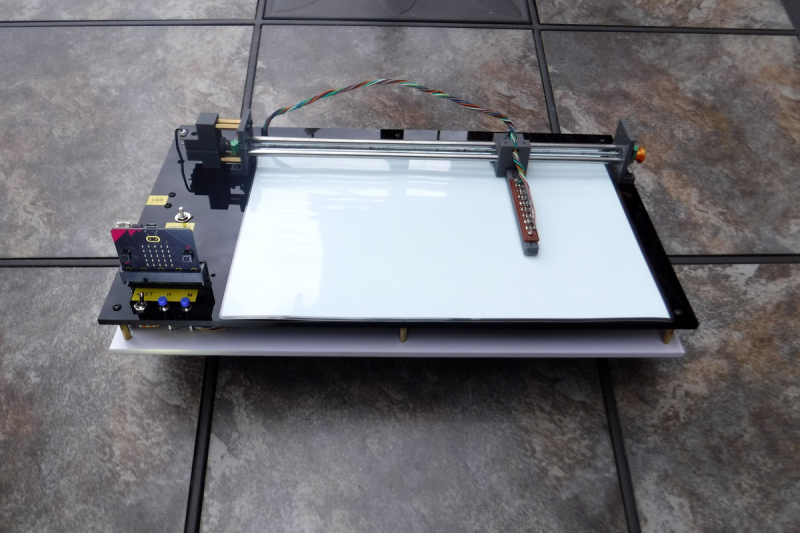It seems there will never be an end to the number of ways to show the time. The latest is the LumiClock from [UK4dshouse], and it uses the seldom-seen approach of a sheet of luminous paper excited by a strip of UV LEDs that pass over it guided by a lead screw.
 At its heart is a micro:bit, which generates the time in dot-matrix digital form as the LEDs are moved across the sheet. It in turn has a real-time-clock module to keep it on time, and it drives a little DC motor via a robotics driver board. The appearance of the whole devices is similar to an X-Y plotter without the Y axis, as a 3D-printed carrier is moved by the lead screw and slides along a pair of stainless steel tubes. The result is an unusual and eye-catching timepiece, whose retro dot-matrix numerals fade away and are refreshed with the new time.
At its heart is a micro:bit, which generates the time in dot-matrix digital form as the LEDs are moved across the sheet. It in turn has a real-time-clock module to keep it on time, and it drives a little DC motor via a robotics driver board. The appearance of the whole devices is similar to an X-Y plotter without the Y axis, as a 3D-printed carrier is moved by the lead screw and slides along a pair of stainless steel tubes. The result is an unusual and eye-catching timepiece, whose retro dot-matrix numerals fade away and are refreshed with the new time.
We’ve had a bit of a play ourselves with UV luminous materials, and we can confirm they make an interesting alternative to some other display ideas in dimmer environments. This isn’t the first such clock we’ve shown you.















Gotta love that eerie glow 🌟
Having made some “persistent shadow” installations (a strobe pops and you walk away, leaving your shadow behind) I have found one of those rare instances where an improvement in technology is not not to your advantage. The ingredients used in these materials now glow so long that they can take hours to fade, rather than minutes or seconds. The refresh time is waaaay too long. The short-term phosphorescent sheets can be hard to source. Perhaps one can use a red laser to “turn off” those glowing bits instead: https://physics.stackexchange.com/questions/79860/why-is-a-laserpointer-able-to-erase-a-glow-in-the-dark-sticker
Interesting. Maybe you could do a “glowing persistent shadow” installation by charging the glowing material, have someone stand in front of it and deactivate by scanning with a red laser (depends on the strength for eye safety) and you end up with glowing shadows on a black background.
I encounted this effect with even very bright red LED lights. Once I was working somewhere that had a Faraday cage airlock entryway: when you walked in the first door the second door wouldn’t open until first closed. Naturally they covered all internal surfaces with glow panels and of course we all goofed around with temporary graffiti.
The effect of red erasing, or turning off, the phosphorescent effect was something that was so outside my experience that I roped two coworkers into being control subjects to test if this was observational bias or a visual receptor overload situation.
Pretty soon everyone discovered the joys of effectively having a “second color” for phosphorescent art/graffiti.
Would the UV from the LEDs cause the paper to glow if applied to the back of the paper? Then again, I guess that it might actually detract from the overall effect to hide the illumination source.
UV causes luminous things to glow like crazy. I replaced all the LEDs in a pocket torch (about 24 from memory) with UV ones. I used it at our big LEGO exhibition to show up the luminous balls we were using as part of our massive GBC (great ball contraption) circuit exhibit. Looked totally awesome with the stadium lights dimmed!
That might make fun game, put up UV graffiti clues around town and have a UV scavenger hunt.
I purchased an alarm clock with a projector function… thought it would be neat. Ended up putting tape over the lens; it proved to be really annoying. At least to me.